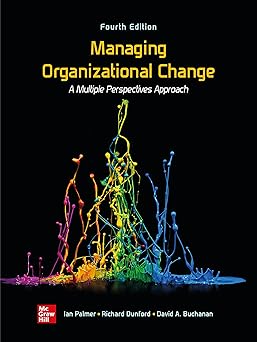Key Highlights
- •Features the unique 'Multiple Perspectives' approach to change.
- •Details various 'Images of Change' for managers.
- •Updated 4th Edition incorporating contemporary insights.
Description
Navigating the tricky waters of organizational change? Feeling overwhelmed by restructures, new tech rollouts, or shifting company culture? Managing Organizational Change: A Multiple Perspectives Approach, 4th Edition is here to guide you! This isnt just another dry textbook; it's a practical guide for understanding and leading change in today's complex business world.
Who is this book for? It's perfect for managers at all levels, HR professionals, business consultants, and students (especially undergrad or MBA) studying business managment or organizational behavior. If you're involved in planning, implementing, or just surviving organizational change, this book is definately for you.
What problem does this book solve? Change is hard. Many initiatives fail because they lack a clear understanding of the dynamics at play. This book tackle that head-on. It helps you move beyond simplistic, one-size-fits-all solutions by presenting multiple perspectives and frameworks. It addresses the common struggle of diagnosing change situations accurately and choosing the most effective managment strategies. Stop feeling lost in the chaos of change; this book provide the clarity you need.
What will you gain from reading it? You'll get a comprehensive toolkit for managing change. Learn about different 'images of change' – like seeing the manager as a director, navigator, caretaker, coach, interpreter, or nurturer. Understand the pressures for change, resistance factors, and various implementation strategies. This book help you develop the skills to lead change more effectively and confidently. You gain both theoretical grounding and practical insights applicable to real-world scenarios.
Why is it worth reading? This 4th edition is updated and relevant, reflecting current challenges in organizational change management. The multiple perspectives approch is its key strength, offering a richer, more nuanced understanding than single-model books. It balances theory with practical application, making it a valuable resource you'll return to again and again. Its widely reccomended in business courses and by professionals for a reason! Ready to master the art of change? Download the PDF now and start transforming how you manage organizational transitions!
FAQ
Is this book suitable for someone new to management?
Yes! While it offers depth for experienced managers, it also explains core concepts clearly, making it accessible for those newer to managment or students.
What exactly are the 'multiple perspectives' discussed?
The book explores different ways to view and approach change, including various 'images' of change managers (like director, coach, navigator) and different theoretical frameworks. This helps you tailor your approach to specific situations.
Does the book include real-life examples or case studies?
Absolutely. The book often uses examples and mini-cases to illustrate the concepts and frameworks, making the theory easier to understand and apply in practice.
How different is the 4th Edition from previous versions?
While the core frameworks remain, the 4th edition typically includes updated examples, recent research findings, and possibly new material reflecting current trends in organizational change to ensure its relevance.
I'm an HR professional. How will this book help me specifically?
It provides valuable frameworks for understanding employee reactions to change, communication strategies, and how to support managers and staff through transitions. It's a great tool for designing and implementing HR-related change initiatives.
Is the focus primarily theoretical or practical?
It strikes a good balance. It provides solid theoretical foundations but strongly emphasizes practical application through its various models, frameworks, and discussion of manager roles.
Reader Reviews
About the Author
Ian Palmer is a respected scholar and author known for his expertise in organizational change and management. His work often focuses on providing practical frameworks grounded in solid research, helping both students and practitioners navigate the complexities of modern organizations effectively.
